Heart Matters – December 2023/January 2024

Radiation Therapy May Be Potential Heart Failure Treatment
Radiotherapy may improve heart function by reducing inflammatory immune cells
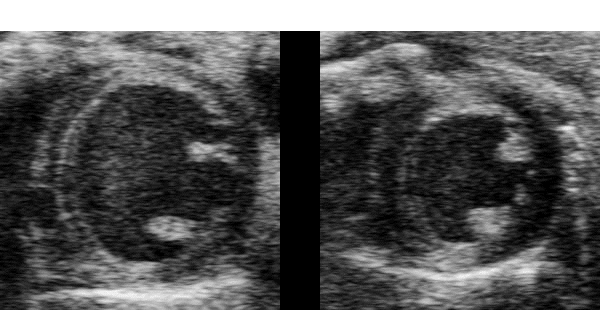
Cardiologists and radiation oncologists at Washington University School of Medicine in St. Louis pioneered the use of radiation therapy — a strategy typically used against cancer — to treat patients with a life-threatening abnormal heart rhythm called ventricular tachycardia.
Now, after studying the cardiac effects of radiation in a small number of these patients and modeling the effects of low-dose radiation in mice with heart failure, the research team has found that low-dose radiation therapy appears to improve heart function in various forms of heart failure. More research is needed before the investigators can evaluate this therapy in patients with heart failure, but the study suggests that radiation’s effects on injured hearts with high levels of inflammation may be more varied — and perhaps beneficial — than previously understood.
The study, published Nov. 28 in the journal Med, suggests that low-dose radiation therapy improves heart function, at least in part, by reducing the number of inflammatory immune cells in the heart muscle.
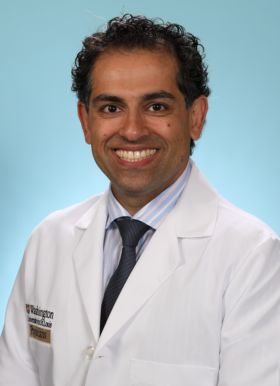
“The radiation therapy used to treat ventricular tachycardia is targeted to a specific location in the heart; however, a large portion of the rest of the heart gets a low-dose exposure,” said co-senior author and cardiologist Ali Javaheri, MD, PhD, an assistant professor of medicine. “We wanted to understand the effects of that low-dose radiation on these patients’ hearts. There was concern that it could be harmful to overall heart function, even though it treats dangerous arrhythmia. We were surprised to find the opposite: Heart function appeared to be improved after radiation therapy, at least in the short term.”
About 6.2 million American adults currently live with heart failure, according to the Centers for Disease Control and Prevention. More than half of heart failure patients hospitalized for the condition die within five years of that first hospitalization, demonstrating a need for better therapies. A failing heart gradually loses its ability to properly supply the body with oxygenated blood. A complex condition, heart failure can have diverse triggers, including a past heart attack, viral infection or chronic arrhythmias such as ventricular tachycardia.
A group of nine patients with ventricular tachycardia was evaluated with cardiac MRI before and after radiation treatment, with the MRIs showing improved heart function soon after radiation. In particular, the patients’ hearts showed improved pumping capacity of the left ventricle, which supplies blood to the entire body. The improvement was seen a few days after treatment, so it was deemed unlikely to be due to the reduction of the arrhythmia, which happens more gradually over the ensuing weeks and months.
The researchers also studied the effects of similar low-dose radiation to the heart in groups of mice with heart failure from three different causes. Similar to what was observed in the human patients, the researchers found improved heart function in mice receiving radiation therapy, especially in the left ventricle. In the mice with progressive heart failure, radiation therapy increased survival of the animals, indicating that improvements in heart function translated to improved survival.
The researchers found that the failing mouse hearts that received radiation had reduced fibrosis — or scar tissue — and reductions in cardiac macrophages, a type of immune cell that can drive inflammation in the heart. In general, the irradiated hearts had fewer cells that proliferate quickly — such as immune cells and fibroblasts — which tend to contribute to worsening heart failure. In contrast, normal heart muscle cells generally do not divide often, if at all.
“We know that rapidly dividing cells — such as cancer cells, for example — tend to be more susceptible to death by radiation,” said co-senior author and radiation oncologist Carmen Bergom, MD, PhD, an associate professor of radiation oncology. “The effect we see in these hearts is likely more complex than a simple reduction of rapidly dividing inflammatory immune cells. We are continuing our research to delve more deeply into what else may be happening, but we have been pleasantly surprised to see evidence that low-dose radiation in these hearts may reduce inflammation and help remodel the heart in a way that is beneficial.”
To understand more about radiation’s effects on the heart, the researchers plan to continue their investigations of the patients already receiving radiation therapy for ventricular tachycardia. The current study showed, via MRI, improved heart function. Next, the researchers plan to conduct more advanced studies to see if there is evidence of reduced inflammation in the human hearts, similar to what they found in mice.
Improving Heart Health to Save Lives During, After Pregnancy Aim of Programs
Community-based approaches in St. Louis and Nigeria supported with NIH grants

The United States and Nigeria may be an ocean apart, but each has distressingly high rates of infant and maternal death in the year following childbirth. In 2021, the Centers for Disease Control and Prevention (CDC) estimated the U.S. maternal mortality rate to be nearly 33 deaths per 100,000 births — about 10 times higher than such rates in several other high-income counties. And in Nigeria, it’s much worse: According to the World Health Organization, the rate is more than 530 deaths per 100,000 births.
To reduce these numbers and save lives, researchers at Washington University in St. Louis and the University of Abuja in Abuja, Nigeria, have received grants to work with community organizations in St. Louis and Abuja, with both projects partnering with Parents as Teachers, a national organization in the U.S. that has long provided support to young families through home visits. Building on the existing home-visiting model, the goal of these programs is to improve cardiovascular health for the mother during pregnancy and for the entire family following delivery. The funds, from two grants totaling $9 million, are from the National Institutes of Health (NIH).
“Nigeria has one of the highest maternal mortality rates in the world,” said cardiologist Mark Huffman, MD, a professor of medicine and co-director of the Global Health Center at Washington University. “And in the U.S., Missouri also has high rates of death during and soon after pregnancy. Many of these deaths are due to hypertensive disorders in pregnancy, especially high blood pressure that can lead to heart failure, seizures, strokes and death. Tragically, these are often preventable conditions. We know what works to lower blood pressure, and the programs we are developing here and in Nigeria are intended to get those interventions to the people who need them most.”
The programs will help families manage their cardiovascular health, and embed healthy eating, physical activity, stress management, sleep and tobacco prevention information and activities within the Parents as Teachers’ curriculum. The teams will aim to help participants control other risk factors for cardiovascular disease, including body weight, blood pressure and blood sugar during and after pregnancy. The researchers will follow the families’ progress, continuing home visits and data collection until the children reach age 2.
“We are taking a multigenerational approach to improving cardiovascular health in families by targeting interventions to the earliest stages of pregnancy and childhood,” said cardiologist Victor Davila-Roman, MD, a professor of medicine, of anesthesiology and of radiology at the School of Medicine. Davila-Roman also serves as director of the Global Health Center, a joint effort between the Institute for Public Health and the Department of Medicine at Washington University.
In St. Louis, the program — Enhancing Cardiovascular Health Equity in Mothers and Children through Home Visiting — is led by principal investigators Debra Haire-Joshu, PhD, the Joyce and Chauncy Buchheit Professor in Public Health at Washington University, Davila-Roman, and Rachel Tabak, PhD, an associate professor at the Brown School. Washington University’s program is one of the seven clinical centers funded to do similar work across the U.S. as part of the NIH’s Early Intervention to Promote Cardiovascular Health of Mothers and Children (ENRICH) program.
In Nigeria, the newly funded program — Enhancing Intergenerational Health in Nigeria: Peripartum as Critical Life Stage for Cardiovascular Health (ENHANCE-CVH) — is led by principal investigators Huffman, who has had long-standing collaborations with colleagues at the University of Abuja; Davila-Roman; Dike Ojji, MBBS, PhD, an associate professor and chair of the Department of Internal Medicine at the University of Abuja; and Godwin Akaba, MBBS, an associate professor and an obstetrician and gynecologist at the University of Abuja.
“We are excited about these two programs, because they promise to be so interactive,” Haire-Joshu said. “There will be so many opportunities for us to learn from one another about the best ways to impart knowledge of cardiovascular health to new, young families. We anticipate learning about new strategies in Abuja that also can work here in St. Louis and vice versa. This is a perfect example of the local-to-global — and back again — collaborations that we’re interested in building between St. Louis and communities around the world.”
Added Dike Ojji, of the University of Abuja: “This program is so important, because cardiovascular diseases and the risk factors, such as hypertension, are the most common causes of mortality and morbidity during pregnancy in Nigeria and Africa as a whole. We are hopeful the program will receive support from the Federal Ministry of Health of Nigeria as it aligns with their policy of reducing maternal and fetal morbidity and mortality.”
In both St. Louis and Nigeria, the researchers are working with Parents as Teachers, a national organization that started and is based in St. Louis. Trained professionals with Parents as Teachers support young families through regular home visits during pregnancy and early childhood, with the aim of partnering with parents to support their child’s development; support positive parent and child interactions; improve parenting practices; boost child and family school readiness; and improve family, caregiver and child health, among other goals.
Past studies involving this program indicate that home visits with young families help them develop healthy habits that nurture early childhood development. The hope is that adding the latest heart health science to the existing approach will cultivate new habits that improve the cardiovascular health of the entire family. Such habits, once established, ultimately also could improve the health of future generations.
“Collaborations between Washington University and Parents as Teachers go back some 25 years,” said Allison Kemner, senior vice president and chief research officer for the Parents as Teachers National Center, which is headquartered in St. Louis. “With this latest partnership, we are taking health interventions shown to help with weight control and diabetes management, for example, and embedding them into the existing Parents as Teachers program. When Washington University brings the science and Parents as Teachers brings the practice with the families, together they can have a powerful effect.”
In Nigeria, the researchers will adapt interventions developed with Parents as Teachers in St. Louis and implement them in Abuja, training community health workers and nurses who work as community health educators to deliver messages about heart health during regular home visits.
The programs will focus on families at highest risk of cardiovascular disease burden, including Black and Hispanic families in St. Louis, families experiencing socioeconomic disadvantages, those affected by obesity, and those in which the parents have a primary school education or less.
‘Excited’ And ‘Scared’ As Experts Seek To Tame ChatGPT And Medical AI
Maddox Featured in Forbes Article on Medical AI

If you find yourself grappling with conflicting feelings about what ChatGPT and similar artificial intelligence chatbots will mean for healthcare, you’re not alone. The president of the National Academy of Medicine, a man whose clinical and research accomplishments place him at the pinnacle of the profession, is doing much the same.
“OK, as a non-AI expert, I should be excited, I should be scared,” NAM president Victor Dzau told attendees at an Academy “issue framing conversation” focused on generative AI and large language models. “But what are we going to do about this?”
Below, we’ll see what ChatGPT recommends. But “excited” and “scared” seem to me precisely the right responses. Though none of the AI experts in a day-long meeting examining the AI landscape and its medical, public health and policy implications were as candid as Dzau, the teetering between terrific and terrifying constituted a constant undertone.
LLMs and generative AI, acknowledged Troy Tazbaz, head of the Food and Drug Administration’s Digital Health Center of Excellence, are “a different paradigm pushing all of us to think differently.” The FDA, he suggested, may need new legal authority to oversee software that could significantly change and evolve after it’s approved for use in a product.
A broader challenge, said Thomas Maddox, a cardiologist who leads the digital health and innovation program at BJC HealthCare, is ensuring that we don’t unwittingly infect AI with our own prejudices. “Because AI is ultimately a reflection of us and all our biases, how can we help AI and ultimately us to be fairer in the care we provide?” Maddox challenged the group.
The NAM has an answer: “You construct a learning healthcare system.” So, too, does ChatGPT. When I posed Maddox’s question to ChatGPT-3.5 (the free version) and chose “Precise” for the type of reply I wanted, ChatGPT quickly provided a five-point plan centered on diversity in data; diversity in people; validation; governance structure; and transparency.
Diwan Installed as Charlie W. Shaeffer, MD Professor
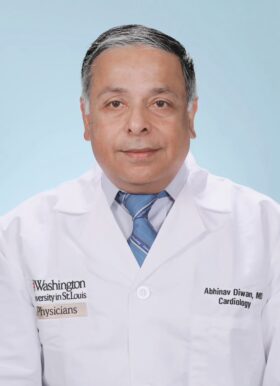
Dr. Abhinav Diwan, Professor of Medicine, Cell Biology and Physiology, Obstetrics and Gynecology and Division Chief of Cardiology at Saint Louis VA Medical Center, has received the inaugural Charlie W. Shaeffer, MD Professorship.
Dr. Diwan was honored on October 24, at the Eric P. Newman Education Center. His presentation for the event was entitled “Lysosomes: The New Frontier in Countering Disease”.
Dr. Diwan is a well-renowned clinician and physician-scientist. He obtained his medical degree from the All India Institute of Medical Sciences and did his Internal Medicine residency and Cardiology fellowship at Baylor University. He moved to Washington University in 2008, where he has made a spectacular career and now holds the title of Professor of Medicine, Professor of Cell Biology and Physiology, and Professor of Obstetrics and Gynecology. He has served in multiple leadership positions, including the Director of the Echocardiography laboratory at the University of Cincinnati, Associate Program Director for the Investigator Training Track of Cardiology Fellowship at Washington University, and Associate Division Chief of Cardiology at the John Cochran Veterans Affairs Medical Center. He has also received national recognition. His national accolades include being named a Fellow in the American College of Cardiology, a title awarded by peers to only the best in their field, being inducted into the American Society of Clinical Investigation, and being recently elected into the Association of University Cardiologists. This association shapes the course of research and training in cardiovascular disease in this country.
Dr. Charlie W. Schaffer, who passed away earlier this year, was a well-known cardiologist who received his medical degree at Washington University with the help of a Danforth Scholarship. In recognition of the importance of the scholarship he had received as a medical student, Schaffer and his wife Claire established the Charlie W. Shaeffer, Jr., MD Scholarship in 2008 for medical students at Washington University in Saint Louis, Missouri. In 2018, they established a fund for this professorship.
Congratulations to Dr. Diwan on this honor.
Stitziel Receives Mid-Career Research Award
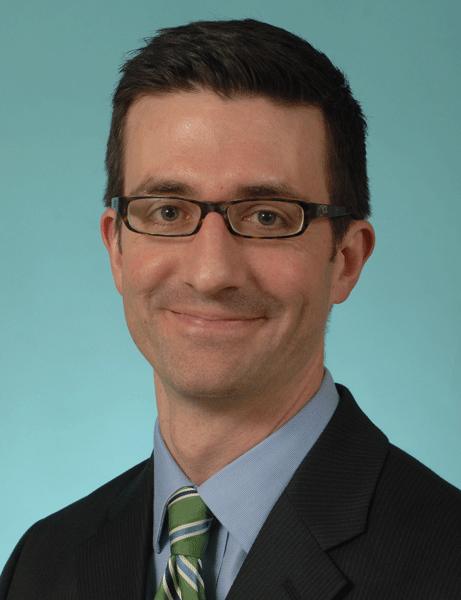
Nathan O. Stitziel, MD, PhD , Professor of Medicine and Director of the Washington University Center for Cardiovascular Genetics, was named the 2023 GPM and EPI Mid-Career Research Award Lecturer at this year’s American Heart Association conference in Pennsylvania.
From the program:
Dr. Nathan Stitziel is Professor of Medicine and Genetics at the Washington University School of Medicine where he is also Associate Director of the Medical Scientist Training Program and Director of Translational Cardiovascular Genetics within the Center for Cardiovascular Research.
After obtaining undergraduate degrees in Mathematics and Physics from Washington University, Dr. Stitziel received a medical degree and PhD in Bioinformatics from the University of Illinois. He completed Internal Medicine training in the University of Chicago’s Physician Scientist Development Program followed by advanced clinical training in Cardiology and Cardiovascular Genetics at the Brigham and Women’s Hospital (BWH) and Harvard Medical School. After a combined postdoctoral research fellowship in Cardiovascular Genetics at the Massachusetts General Hospital (MGH), Broad Institute, and BWH, Dr. Stitziel joined the MGH faculty before returning to Washington University in 2012.
Dr. Stitziel directs a basic science and translational research program focused on identifying novel genes and molecular pathways underlying the inherited basis of cardiovascular disease, aiming to discover and validate novel drug targets and improve patient care. To pursue this work, his group utilizes a collaborative and multi-disciplinary approach, combining innovative methods in human genetics and genome science with classical techniques in molecular biology and animal model systems. Employing these techniques, his lab has made substantial contributions to our understanding of mechanisms promoting atherosclerosis and other heritable cardiovascular diseases. In recognition of his scientific contributions, Dr. Stitziel has received multiple awards including the GPM and EPI Mid-Career Award from the American Heart Association and election to the membership of the American Society of Clinical Investigation.
Cresci and Bach Publish On EXPLORER-HCM Study
Drs. Richard Bach and Sharon Cresci of the Washington University Hypertrophic Cardiomyopathy Center of Excellence, along with collaborators, have published “Effect of Mavacamten in Women Compared With Men With Obstructive Hypertrophic Cardiomyopathy: Insights From EXPLORER-HCM” in the journal Circulation.
“Compared with men, women with hypertrophic cardiomyopathy (HCM) have a higher incidence of heart failure and worse outcomes. We investigated baseline clinical and echocardiographic characteristics and response to mavacamten among women compared with men in the EXPLORER-HCM study”, writes Cresci.
The study found similar outcomes in women compared with men in improvements in primary and secondary end points of the study, and greater overall improvements in health status for women enrolled.
Peterson Publishes Editorial in JACC: Cardiovascular Imaging
Dr. Linda Peterson, Professor of Medicine and Radiology and Medical Director of Washington University Cardiac Rehabilitation, has published a new editorial in the journal JACC: Cardiovascular Imaging.
“Sarcopenia and Coronary Microvascular Dysfunction- Attention Must Be Paid” was written by Peterson and collaborator Thomas H. Schindler, MD, PHD of the Washington University Mallinkrodt Institute of Radiology.
The editorial was a response to “Body Composition, Coronary Microvascular Dysfunction, and Future Risk of Cardiovascular Events Including Heart Failure” by Souza, et al, in the same issue of JACC: Cardiovascular Imaging.
Cardiovascular Division Members Receive COVID Awards
This past summer the Washington University School of Medicine Office of Faculty Development solicited nominations to recognize outstanding individuals for their work and contributions in the Department of Medicine during the COVID-19 pandemic.
The awards were presented November 28th. The following members of the Cardiovascular Division were honored:
- Joan Avery (Research Lab Manager) – COVID Unsung Hero Award
- Lisa Ford, MSN, RN (Nurse Manager) – COVID Unsung Hero Award
- Jennifer York (Director, Clinical Services) – COVID Unsung Hero Award
- Samuel Lindner, MD (former fellow) – COVID Rising Star Award
- Majesh Makan, MD (Professor of Medicine) – COVID Star Award
- Amanda Verma, MD (Assistant Professor of Medicine) – COVID Star Award




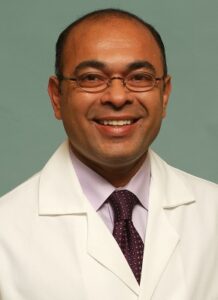

Keep up to date with all Division news on our news page!
Way to Shine!
“Washington University Physicians and the scheduling staff are exceptional. Keeyonna (Harrison) went out of her way to coordinate my visits with Dr. Gleva and Dr. Hartupee for the same day since my drive is three hours. She went above and beyond to help me.”
Other Way to Shine’s for this month were Lisa Fields, Nikki Madigan, Doris Lehmann, Connie Stone, Allison Schremp, Emma Porter, Jill Powles, Millie Cova, Lisa Murphy, Rachel Henry, Carolyn Iezzi, Victoria Menning, Katherine Ramsay, Deana Wilmesher, Megan Hangyal, Anne Yoggerst, Anita Johnson, Lauren LaRose, Gina Bliss-Braymer, Ryan Gillam, Karen Moore, Jenifer Abbas, Tonya Becker, Kathleen Cross, Matthew Falkinburg, Angela Higgins, Craig Hunt, Sylvia Kimani, Joan Krull, Melissa Lovell, Erin Pinkerton, Angie Smith, Stephen Tepen, Katie Wehmeier, Luann Wierzchucki, Lisa Winter, Rebecca Menley, Holley Crabtree, Morgan Porter, Lisa Ford, Barbara Stehman, Dana Gima, and Cheryl Marshall.
If you catch someone in the act of shining, contact or send an email to bolhafner@wustl.edu.
CCR Spotlight: Javaheri Lab
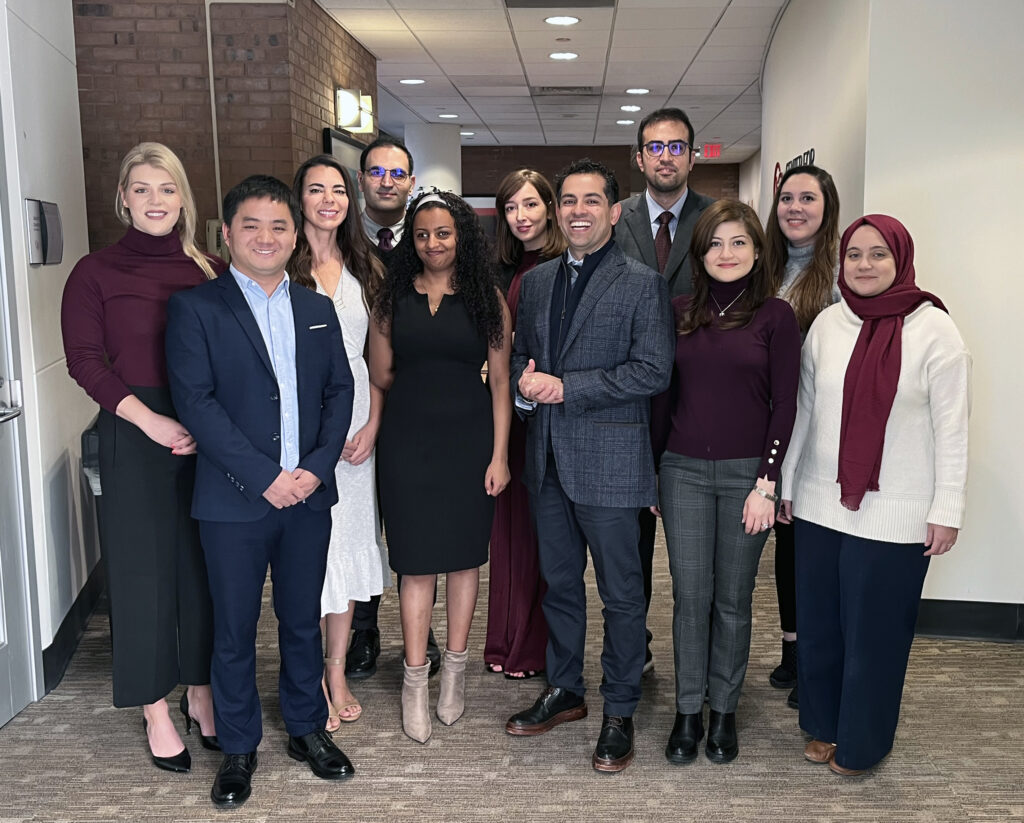
Each month, Heart Matters will highlight a research lab or clinical program. We want everyone in the division to be proud of the work we do across all of our locations and disciplines.
The Javaheri Lab, part of the Cardiovascular Center of Research, is primarily focused on the role of lipids in myocardial health and disease. The lab has basic and translational projects, as well as a focus on clinical projects that span a large breadth of research to find treatments which improve heart function.
The team, led by Ali Javaheri, MD, PhD, also includes postdoc researchers Anna Ataran, Zhen Guo, Hamidreza Hajirezaei, Aynaz Lotfinaghsh, Mualla Ozcan, and Carla Valenzuela Ripoll. Kana Miyata is a visiting researcher in the lab, and Amen Bekele Zelleke is the research coordinator. Stephanie Stilinovic is the manager of clinical trials for the lab. They work closely with the Bergom Lab in the Radiation Oncology Department, including Dr. Carmen Bergom, postdoc researcher Lauren Pedersen, visiting researcher Alireza Sargazi.
The collaboration with the Bergom lab recently resulted in a breakthrough study published in the journal Med, which is highlighted in the opening article of this month’s newsletter. While in the past cardio-toxicity from radiation has been a focus, the researchers found that targeted doses of radiation show improvement in heart function in mice and humans with ventricular tachycardia. Radiation therapy also improved survival rates in mice with progressive heart failure.
While more research is needed, this is an exciting application of radiation as a potential therapy for patients with heart diseases or heart failure. Lauren Pedersen says that collaboration between labs is important for this work, as expertise in heart cells and pathways in the Javaheri Lab meets the Bergom Lab’s radiation knowledge and techniques. Dr. Javaheri notes that heart failure and inflammatory diseases, involves “rapidly dividing cells”, just as cancer does which is targeted by radiation therapy. He adds, “dose matters, condition matters”.
Another recent publication that illustrates that not all therapies are healthy for every case focused on intermittent fasting, finding that fasting in the wrong setting can be toxic. The study, using mice being treated with chemotherapy, showed that intermittent fasting caused multi-organ stress response and toxicity in mice with heart failure. If a human patient with diabetes and heart failure were undergoing chemotherapy, this study shows that a fasting approach that may be appropriate for the diabetes could be dangerous when the heart failure is taken into account.
Stephanie Stilinovic joined the lab to manage the clinical trial side, and works with Mualla and Carla on these projects. The lab was the national lead for the NECTAR trial studying COVID effects, and is one of the top sites for the ongoing FASTER heart failure trial. She says that it is exciting that the lab has these projects, which bridge mouse and human approaches.
Amen, who joined the lab only a few months ago, finds she has already learned a lot. The researchers of the lab enjoy a cooperative environment, and enjoy sharing knowledge and ideas.
Carla adds that “Ali is a great mentor” and encourages collaboration and growth. “Our ultimate goal is to find treatments and interventions for heart failure, and cardio toxicity from cancer treatment,” she says that this goal keeps her motivated in her work. This motivation and the dedication of the whole team translates into a great deal of important work coming out of the Javaheri Lab.
Division Staffing Updates
Positions open for hiring:
JR77972 Clinical Research Study Assistant II – Clinical Trials
JR77820 Clinical Specialist PT/OT (PRN) – Clinical Trials
JR77910 Registered Medical Assistant II (West County) – West County practice
JR77584 Registered Medical Assistant III (South County) – South County practice
JR72592 Research Cardiac Sonographer (PRN) – CORE Lab
JR74188 Research Opportunities – Dr. Prabhu’s Lab
JR73579 Research Specialist – MOUSE CORE
JR75743 Research Technician II – Dr. Javaheri’s Lab
JR78183 RN Research Nurse Coordinator I – Clinical Trials
Welcome to the Cardiovascular Division:
Katie Kyle – Research Lab Supervisor – Dr. Kory Lavine’s Lab – 11/1/23
Sharon Heuerman – Research Nurse Coordinator II – Clinical Trial Research Operations – 12/4/23
Kyleen Brumit – Medical Assistant II – West County practice – 12/15/23
Molly Krummenacher – Administrative Coordinator – CCR – 12/11/23
Jordyn Bommarito – Senior Grants Specialist – Research Administration – 12/4/23
Aida Loera – Medical Secretary – Cath Lab Administration – 11/27/23
Lesley Alexander – Research Nurse Coordinator I – Clinical Trial Research Operations – 11/6/23
Congratulations On Your Promotion!:
Debra Hunter – Purchasing Supervisor – 11/6/23
Pam Solon – Manager Financial Planning – 12/4/23
Farewell:
Farewell to these Cardiovascular Division employees. Thank you for your service, you will be missed!
Emma Stewart – Last Day 11/7/23
Jordan Harris – Last Day 11/17/23
Betty Level – Last Day 12/8/23
Dr. Benjamin Kopecky – Last Day 1/1/2023
Tanya Madden – Last Day 2/2/24
Cardiovascular Division Holiday Party
On December 16th, the Cardiovascular Division celebrated with a holiday party! The event was held at the Moto Museum near Grad Center, and was festive and fun for all. We hope that whether or not you were able to attend, your holidays brought joy.
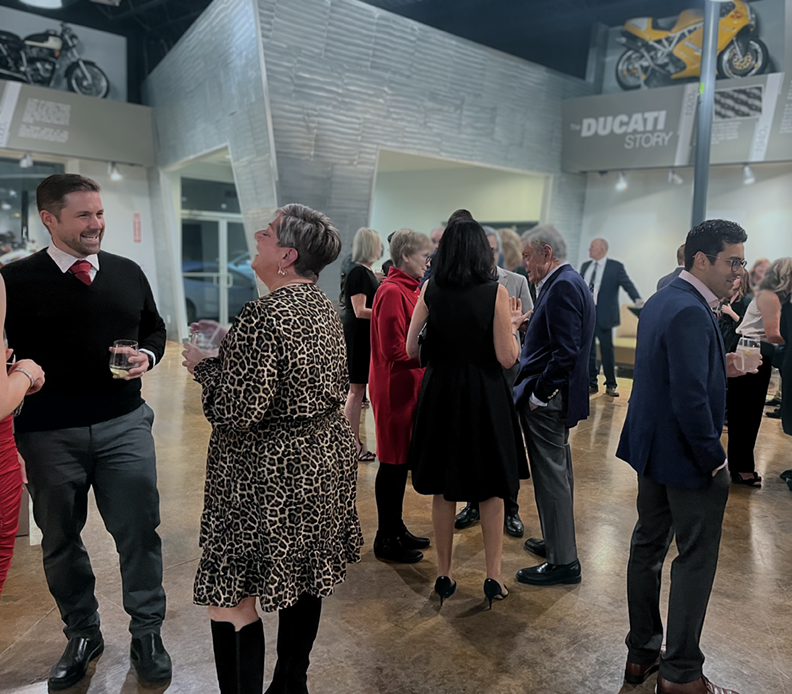
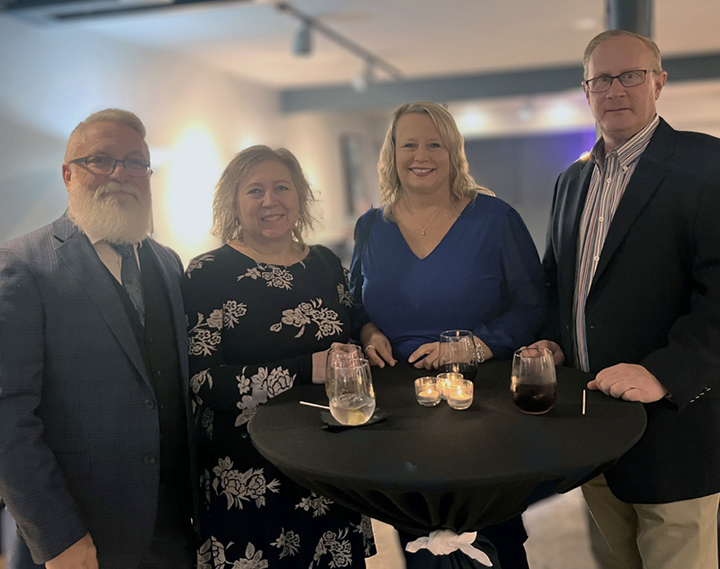





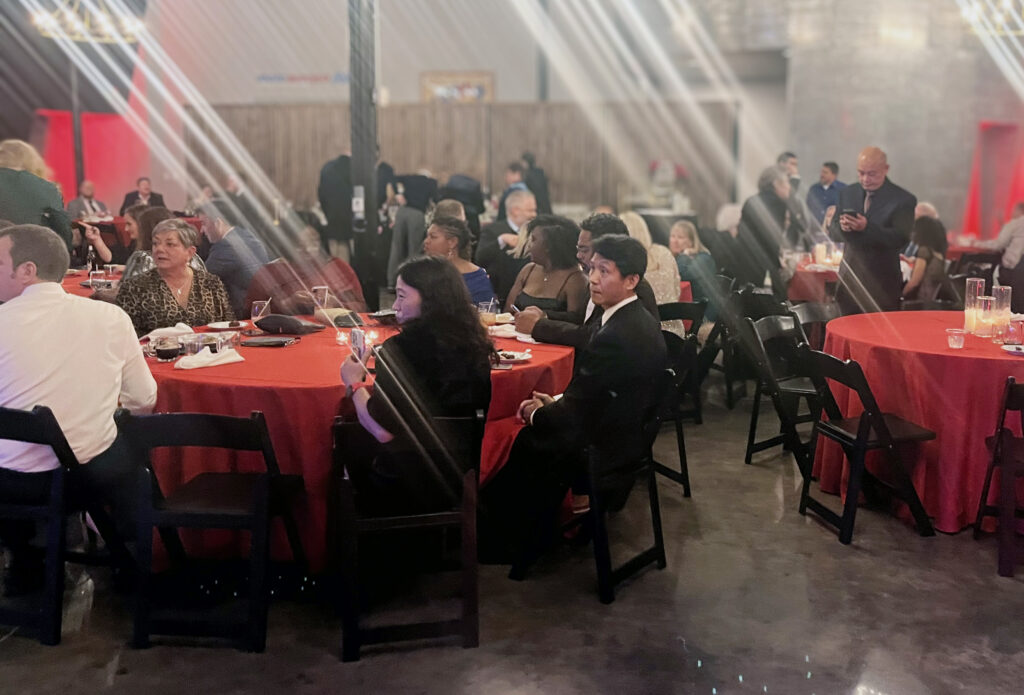
Football Rivalries in the Cath Lab
The Cath Lab at Barnes-Jewish Hospital is not only home to excellent cardiovascular care- it also hosts a fierce Big Ten college football rivalry! Whether their allegiance is inspired by their hometown or their Alma Matter, several of the cath lab members don themed gear like scrub caps during football season to cheer on their teams.
Drs. Giacomino and Schilling support the Wisconsin Badgers. Dr. Thakker and nurse Bob Massey are Ohio State Buckeyes fans. Dr. Kurz loves the Michigan State Wolverines, while Dr. Sintek is a diehard fan of the Nebraska Cornhuskers. The interventional and EP fellows get in on the action, with Dr. Vince Siebert pulling for the Illinois Fighting Illini, Dr. Noah Williford cheering for the Iowa Hawkeyes, an Dr. Christopher Evanson splitting his allegiance between Ohio State and the Purdue Boilermakers.
The friendly competition can heat up with wagers, for instance the supporter of a losing team in a big match-up having to buy the winner of the supporting team a 6-pack- or having to wear the winners’ team scrub cap for a week!
“There’s a lot of trash talking”, reports Dr. Giacomino. She once left a note for Dr. Sintek when her beloved Badgers were playing his team with this joke:
Why does Nebraska Football not have a website?
Because they can’t string together 3 W’s!
Win or lose, the cath lab team is a touchdown for patients!

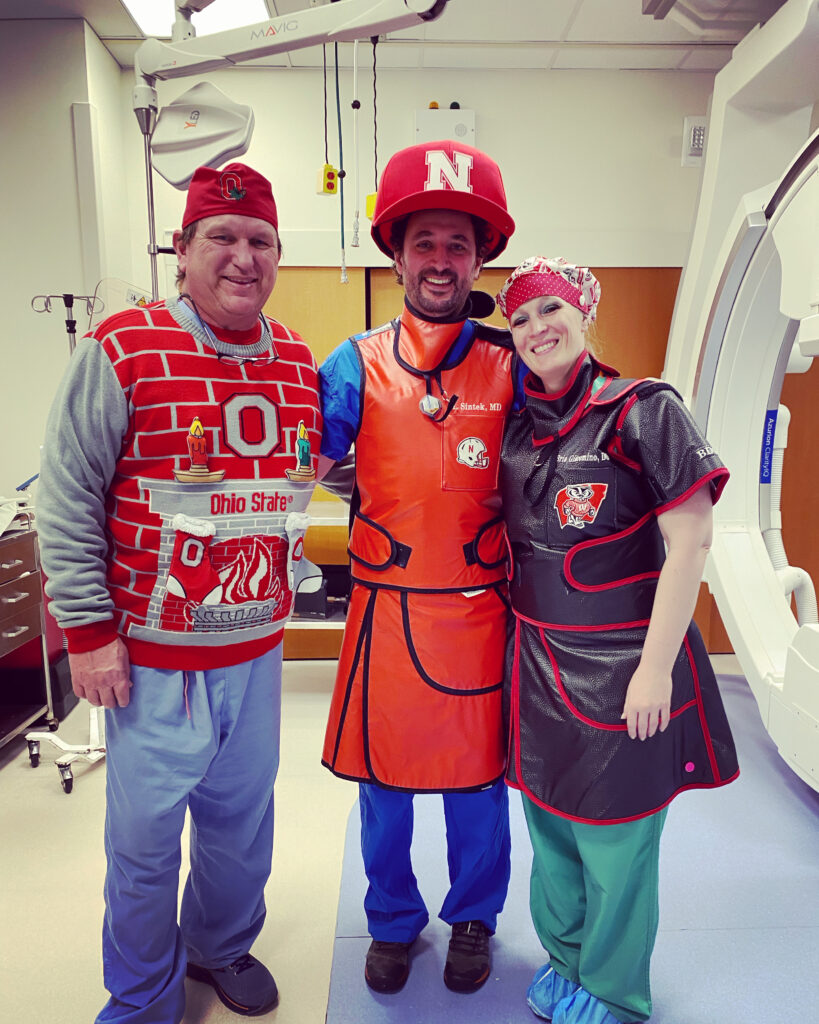
Janet Schwaninger Tree Dedication
In December, Forest Park Forever completed the process of dedicating a tree in memory of Janet Schwaninger.
The tree chosen is a Redbud tree located in Forest Park at Murphy Lake, a small, secluded lake Janet would have enjoyed for its peaceful nature.
Thank you to those who were able to donate to make this possible.

Breakfast With the Chief
We are delighted to announce a new “Breakfast with the Chief” initiative for our teams. We are going to hold breakfasts for our staff twice per year, rotating through the various Cardiology locations. This gives our teams time to connect with Dr. Prabhu.
Our first two breakfasts are as follows:
- January 5th from 8-9 am at the 13th floor Northwest Tower kitchen
- January 29th from 8-9 am at the West County Cardiology Practice and the Heart Care Institute in the Demonstration Kitchen
Nominate a Colleague for the Drum Major Awards!
The Drum Major Awards will recognize individuals at WashU School of Medicine who embody what it means to be an upstander. Awardees should be those who speak up or act in support of an individual or cause, particularly someone who intervenes on behalf of a person being bullied or attacked. Upstanders are people who speak and act against injustices.
We want to uplift members of the WashU Medicine community, from every corner, who are doing this work. From leading community-wide service projects or standing up for others in the face of injustice, upstanders represent the best of humanity today across the School of Medicine. They harness their character strengths to meet their moment and pursue justice, both great and small, inspiring others to do the same.
We are seeking nominations (https://wustl.az1.qualtrics.com/jfe/form/SV_eh9QFLfnWkbSdf0) of members of the WashU Medicine community for Drum Major Awards. Please fill out the form below no later than January 14th, 2024 at 11:59pm (CDT). Please email joeltdalton@wustl.edu with questions or concerns. If awarded, your nomination will be sent directly to the nominee as well as to their manager/supervisor. Similarly, awardees will be honored during the WashU Medicine DEI Update on Tuesday, January 16th, 2024.
Health and Wellness
Chocolate Cravings? All Things in Moderation
Emma Greenhill, MS, RD, LDN
Do you like to consume dark chocolate in moderation? Me too. Let’s face it — chocolate is one of life’s most decadent treats. But you may be excited to learn there are actually health benefits to consuming 1-ounce of dark chocolate per day.
Nutrition Facts. One ounce of 60% to 70% dark chocolate contains approximately 160 calories, 11 grams total fat, 6 grams saturated fat, 15 grams total carbohydrates, and 2 grams protein. This treat should be used as a dessert, complimenting a well-balanced meal.
Vitamins & Minerals. One ounce of 60% to 70% dark chocolate contains 19% daily value of manganese, 17% daily value of copper, 12% daily value of magnesium, 10% daily value of iron. Dark chocolate also provides smaller amounts of phosphorus, potassium, zinc, selenium, and calcium. And as far as vitamins go, dark chocolate provides some vitamin K, vitamin B12, thiamin (B1), riboflavin (B2), niacin (B3), and pantothenic acid (B5).
Antioxidants. Chocolate is rich in plant chemicals called flavanols. Dark chocolate contains two to three times more flavanol-rich cocoa solids as compared to milk chocolate. Flavanols are antioxidants linked to a lower risk of heart disease.This is because flavanols are related to the production of nitric oxide, which relaxes your blood vessels and improves blood flow. The cocoa bean is also a rich source of the antioxidant theobromine, an alkaloid which helps reduce inflammation and may help lower blood pressure. Theobromine is extracted from the bean husks, as it is slightly water-soluble, and used in the synthesis of caffeine. This antioxidant has a slightly bitter taste.
Milk, Dark, or White. Milk chocolate contains at least 10% cocoa solids (sometimes up to 50%) and 12% whole milk, while dark chocolate (bittersweet chocolate) contains 50%-90% cocoa solids. White chocolate does not contain cocoa solids or cocoa powder, so technically white chocolate isn’t chocolate at all. It’s made using a combination of sugar, cocoa butter, milk, and soy lecithin. Therefore, dark chocolate provides the most vitamins, minerals, and antioxidants for the least amount of added sugar grams.
Studies. Studies have found numerous health benefits in chocolate consumption. The journal Heart published a 2015 study which reviewed food frequency questionnaires of 20,951 participants. The researchers found that habitual chocolate eaters had a lower risk of coronary heart disease and stroke compared with men and women who did not consume chocolate. This however could be because those participants restricting themselves to 1 ounce of dark chocolate per day were avoiding richer and more extravagant desserts. Therefore, larger doses of chocolatey desserts are not recommended.
Recommendation. Although chocolate, especially dark, contains a plethora of nutrients, it’s high in calories. If clients want to include chocolate in their diet, then they should consume 1 ounce of 60% to 70% dark chocolate per day. This moderate portion will help keep calories and saturated fat grams in check.
Chocolate-Covered Strawberries

Serves: 12 strawberries • Prep Time: 50 mins • Total Time: 50 mins
Ingredients
- 8 ounces strawberries ripe but firm (12 medium strawberries)
- 3 ounces dark chocolate chips*
- 1 teaspoon avocado oil
Directions
- Line a plate or a tray with wax paper. Wash the strawberries and pat them dry with a paper towel.
- Place the chocolate chips in a microwave-safe bowl. Melt them in the microwave in 30-second sessions, stirring after each session. They should be mostly melted after three such sessions.
- Stir the oil into the melted chocolate.
- Dip each strawberry into the melted chocolate. Lift up and twist around to get rid of any excess chocolate. Place on the wax paper.
- Chill the strawberries in the fridge for 30 minutes before serving.
Tips
- *You won’t use all the chocolate, but you need all of it to properly dip the strawberries. I usually use about 2 oz of chocolate. The nutrition info reflects that.
- You can keep the leftovers in the fridge, in an airtight container, for up to two days. But it’s best to eat them on the day you make them, or they could become mushy. I don’t recommend freezing the leftovers.
Nutrition Information
Serving: 3 strawberries | Calories: 107kcal | Carbohydrates: 9.5g | Protein: 2g | Fat: 6g | Saturated Fat: 5g | Sodium: 0.6mg | Fiber: 2g | Sugar: 5.5g
References
- Recipe courtesy of: https://healthyrecipesblogs.com/chocolate-covered-strawberries/#recipe
- https://www.todaysdietitian.com/newarchives/0216p10.shtml
- https://health.ucdavis.edu/blog/good-food/dark-chocolate-health-benefits-the-good-and-the-bad-to-this-sweet-treat/2023/02
- https://health.clevelandclinic.org/dark-chocolate-health-benefits
- Kwok CS, Boekholdt SM, Lentjes MA, et al. Habitual chocolate consumption and risk of cardiovascular disease among healthy men and women. Heart. 2015;101(16):1279-1287.
Do you have BJC Cigna? Remember that you have annual coverage to meet with me, Emma Greenhill, a Heart Care Institute dietitian. Call 314-996-8165 for more insurance information or to schedule an appointment.
Live Near Your Work program expands
In an effort to better support employees and spur investment in historically disinvested neighborhoods in St. Louis and St. Louis County, BJC HealthCare and Washington University in St. Louis expanded their Live Near Your Work homeownership and neighborhood stabilization program.
The Live Near Your Work program is available to all benefits-eligible Washington University and BJC employees systemwide. The program offers a limited number of $12,500 forgivable home loans — an increase of $4,000 since the program began in 1997.
The program also has greatly expanded to include more neighborhoods that have faced historic disinvestment, primarily in St. Louis city and north St. Louis County as well as University City’s Third Ward. These neighborhoods were selected to align with local and regional initiatives, working to advance racial equity and economic opportunity.

“The Live Near Your Work program was designed to ease the financial burden of buying a home for BJC and Washington University employees, while helping to improve the economic health of our region,” said Deidre Griffith, BJC vice president of community health improvement. “The expanded regions in St. Louis city and north St. Louis County have been significantly impacted by systemic racial and spatial inequities. By including these communities, we are working to create positive outcomes through equitable investment and economic development.”
Qualifying employees can apply for a forgivable loan to be used toward a down payment or closing costs. After five years, the loan is forgiven as long as the employee continues to reside in the home and hold a benefits-eligible position at BJC or Washington University.
Lisa Weingarth, senior advisor for St. Louis initiatives at Washington University, said Live Near Your Work is an example of both institutions’ ongoing efforts to make St. Louis healthier and more prosperous for all.
“As the region’s two largest employers, we at BJC and Washington University take seriously our obligation to the region,” Weingarth said. “We do that by delivering excellent patient care to the region, supporting local businesses and by expanding economic and educational opportunities for our combined workforce of more than 52,000 employees.”
Since Live Near Your Work’s launch 26 years ago, BJC and Washington University have continuously increased the program’s annual budget, eligible neighborhoods and size of forgivable loans. Today, both institutions have committed $300,000 per year each for the program.
Anne Peterson, a business analyst for University Advancement, is one of the more than 400 employees who have leveraged the program to finance a home. In 2019, she bought an abandoned house in St. Louis’ West End neighborhood near the Delmar MetroLink station. The property had been ravaged by an electrical fire and was littered with old tires and trash.
“There were a lot of reasons to run screaming from the house,” Peterson said. “The Live Near Your Work program allowed us to design the home we wanted. The program was easy to access and the support we received was terrific.”
Take Care Series: Mindfulness Practices to Help with the Winter Blues

Experience the transformative power of mindfulness with consultant Meg Krejci in a virtual session aimed at alleviating the winter blues and embracing the joys of the season. Explore further mindfulness classes and resources provided by WashU’s signature Move into Mindfulness program.
Offered Via Zoom.
UHC Digital Medical Cards
WashU’s healthcare provider, UnitedHealthcare, is moving towards digital ID cards for easy access. Here’s how to view your digital card and order a physical copy, if preferred:
- Log in to myuhc.com using your HealthSafe ID®. If you do not have a HealthSafe ID®, follow the instructions to register.
- Click “View & Print Subscriber ID Cards”
- Select “Mail ID Card” to receive a physical copy
You can also call 800-382-2599 to request a physical copy.
Financial literacy series: Estate Planning
Financial literacy leads to better financial health
Planning and saving for our financial future can help bring peace of mind and opportunities as we make our way through life, but it can be hard to know where to start sometimes. At WashU, we know that financial literacy leads to better financial health. That’s why we’re providing this series of education, tools and professional support to employees.
Financial literacy refers to the knowledge to make informed decisions about your own financial situation – from budgeting to investing to saving. It can help us meet our financial needs now and in the future, and increase our ability to choose important and meaningful experiences that can contribute to our well-being.
Estate Planning: Secure their tomorrow
Thinking about what happens to your assets when you die can be overwhelming or difficult to think about, but having an estate plan makes sure the things you worked hard for go to the people or organizations you care about. To get started, let’s break down the different documents you may want to consider starting or updating.
Estate Plan Overview
An estate plan serves as the legal framework through which your assets are managed and distributed after your death. A comprehensive estate plan typically includes:
- Last Will and Testament | A document specifying how your estate is distributed among your chosen beneficiaries.
- Living Will (Health Care Directive) | This document outlines your medical treatment preferences in circumstances in which you are no longer able to express informed consent.
- Trust | A legal entity holding asset ownership for designated individuals, bypassing probate and providing specific instructions for distribution.
Financial Tools and WashU Benefits
Supplementing your estate plan, consider these essential financial tools available through WashU’s employee Life and Income Protection benefits:
- Life Insurance | A safeguard ensuring financial support for your dependents in the event of your passing, offering security and stability.
- Long-term Care Insurance | Assisting in covering expenses linked to long-term care needs, serving as a protective measure against potential healthcare costs.
Call to action
- Think about your goals for any assets you plan to distribute, then put pen to paper. Work-Life Solutions offers discounts and resources for employees who wish to draft a last and/or living will.
- Review your financial accounts (including savings, retirement, life insurance, etc.) to ensure you have an updated beneficiary assigned. Common WashU accounts include:
- TIAA retirement account | Log into your account at TIAA.org/wustl. Under actions, select “Add/edit beneficiaries”
- Health Savings Account (HSA) | Log into Optum, select the “Tools and Resources” tab, then click on “Beneficiary Designation Form”
- Life insurance | View plan details and instructions
Dive Deeper
Explore Enrich, WashU’s financial well-being platform, offering interactive finance courses, informative articles, videos and access to financial coaches. Log in to Enrich to access articles and videos (3-5 minutes each) covering estate planning and wills, and discover specific resources related to estate planning:
- Everything You Need to Know to Get Started with Estate Planning | Enrich’s comprehensive guide on estate planning tailored to your unique circumstances.
- Preparing an Estate Plan | This course explores the estate planning process and the role an estate plan plays in helping people prepare for the unexpected.
IT Spotlight: New Microsoft Teams

Microsoft’s commitment to enhancing user experience has led to the development of a new feature that allows users to explore the latest version of the Microsoft Teams app effortlessly. With the introduction of the “Try the New Teams” toggle button, users now can embrace a more streamlined and efficient communication and collaboration platform.
Teams 2.0 at WashU
University users can access a variety of new features by using the toggle button, including enhanced customization options, enhanced video conferencing capabilities, and advanced security protocols. The updates are designed to facilitate smoother communication and collaboration, resulting in a more productive and engaging digital workspace for everyone.
New Microsoft Teams (Teams 2.0) will allow you to navigate between WashU and BJC M365 tenants more quickly, receive WashU notifications while working in the BJC tenant, and switch Teams orgs during Teams meetings without being dropped from the call, regardless of the hosting organization.
The Classic Teams service will continue to be available until March 5th, 2024. We recommend that Classic Teams users update to “New Teams” as soon as possible to take advantage of the new features and capabilities that are only available in New Teams.
Reverting to the older version is as simple as switching off “New Teams” in the toggle button in the top left corner of Teams.
Key Dates
December 15th, 2023:
• “Try the New Teams” toggle button feature will be available to university users, Classic Teams will remain operational for Washington University.
March 5th, 2024:
• New Microsoft Teams (Teams 2.0) will be the required teams experience for Washington University. Classic Teams will be retired for all university users.
For support, call us at (314) 933-3333, email us at ithelp@wustl.edu, or submit a ServiceNow Support Request.
| Keep up to date with IT news at the Office of Information Security blog |
Follow the Cardiovascular Division on X!
Check out our division account, @WashUCardiology! We will be sharing division accomplishments, announcements, news, events, and more. If you have a story about the cardiovascular division that you think deserves a social media spotlight, email bolhafner@wustl.edu.